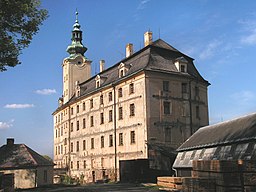Fulnek
| Fulnek | |||
| Town | |||
|
Fulnek Castle
|
|||
|
|||
| Country | Czech Republic | ||
|---|---|---|---|
| Region | Moravian-Silesian | ||
| District | Nový Jičín | ||
| Commune | Odry | ||
| Municipality | Fulnek | ||
| Elevation | 258 m (846 ft) | ||
| Coordinates | 49°43′N 17°55′E / 49.717°N 17.917°ECoordinates: 49°43′N 17°55′E / 49.717°N 17.917°E | ||
| Area | 68.46 km2 (26.43 sq mi) | ||
| Population | 5,921 (Dec2011) | ||
| Density | 86/km2 (223/sq mi) | ||
| First mentioned | 1293 | ||
| Mayor | Jana Mocová | ||
| Timezone | CET (UTC+1) | ||
| - summer (DST) | CEST (UTC+2) | ||
| Postal code | 742 45 | ||
| NUTS | CZ0804 599352 | ||
| Statistics: statnisprava.cz | |||
|
Website: www |
|||
Fulnek (Czech pronunciation: [ˈfulnɛk]; German: Fulnek) is a town in the Moravian-Silesian Region, Czech Republic, exactly 29,2 km south from Opava and 40 km west from Ostrava.
Interesting places- Fulnek Castle, Holy Trinity Church, Plague Column, Museum J.A.Comenius, Augustinian monastery.
The town was created in the time of the big colonisation of northeast Moravia and located near the well known Amber Road, important trading route connecting Mediterranean areas with Baltic sea coasts.
Through years Fulnek was a manor owned by several noble families. During a period of prosperity, acting of members of Unity of the Brethren provided high development of education. A very important representative was John Amos Comenius, who has spent there three most beautiful years of his life - as he said himself. After the defeat of Bohemian Revolt (in 1621) he had to escape from the town.
Until 1918, FULNEK was part of the Austrian monarchy (Austria side after the compromise of 1867), in the NEUTITSCHEIN - NOVÝ JIČÍN district, one of the 34 Bezirkshauptmannschaften in Moravia.
In 1938, it was occupied by the Nazi army as one of the municipalities in Sudetenland. The German-speaking population was expelled in 1945 (see the Beneš decrees) and replaced by Czech settlers.
...
Wikipedia







